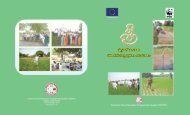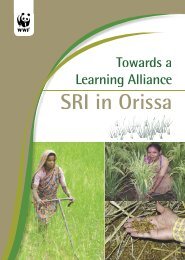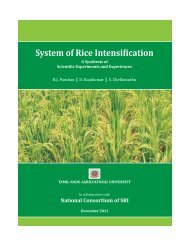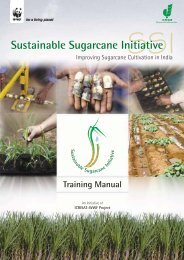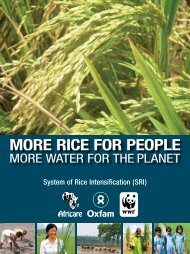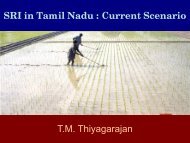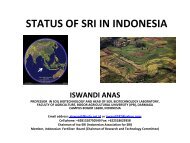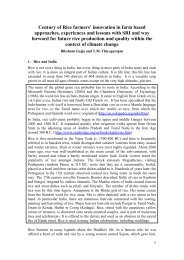SSI Newsletter - SRI - India
SSI Newsletter - SRI - India
SSI Newsletter - SRI - India
Create successful ePaper yourself
Turn your PDF publications into a flip-book with our unique Google optimized e-Paper software.
Fundamentals of<br />
Sustainable Sugarcane Initiative<br />
Sustainable Sugarcane Initiative (<strong>SSI</strong>) aims at providing practical<br />
options to farmers in improving the productivity of land, water<br />
and labour, all at the same time. <strong>SSI</strong> is also expected to<br />
reduce the overall pressure on water resources and<br />
contribute to recovery of ecosystems in the<br />
long run. Below is a description in<br />
brief of some of the essential<br />
practices under <strong>SSI</strong>.<br />
What is <strong>SSI</strong>?<br />
Sustainable Sugarcane Initiative (<strong>SSI</strong>) is a system of<br />
better management practices that involves use of<br />
less seeds, less water and optimum utilisation of fertilizers<br />
and land to achieve more yields and profits to farmers and millers alike.<br />
It is an alternative to the conventional seed, water and space intensive<br />
sugarcane cultivation. The main principles of <strong>SSI</strong> are:<br />
SugarCane<br />
matters<br />
22<br />
Nov ‘09<br />
Raising nursery<br />
using single<br />
budded chips<br />
Conventional sugarcane cultivation consumes two to<br />
four tonnes of cane per acre because 2-3 budded cane<br />
cuttings, called setts, are used as seed material. On the<br />
other hand, in <strong>SSI</strong>, instead of using 2-3 budded cane<br />
setts, the area of bud only is chipped with the help of a<br />
instrument called Bud Chipper. The chipped buds are then<br />
placed in coco-pith (coir waste) filled plastic trays for<br />
raising the nursery. Only 500 kilograms of cane needs to<br />
be cut to be used for bud chips as seed materials. A point<br />
to be noted here is, unlike the conventional method, the<br />
seed requirement comes down due to minimum spacing<br />
of 5 feet between rows and 2 feet between plants, is<br />
recommended under <strong>SSI</strong>. Of the 500 Kilograms again,<br />
only 50 kilograms of bud chips are required for actual<br />
use (which is about 95% of saving).<br />
1 3<br />
Maintaining<br />
wider spacing in<br />
the main field<br />
<strong>SSI</strong> advocates wider spacing between rows and plants<br />
(4-6 X 2 ft), unlike the conventional close spacing (1.5<br />
to 2.5 ft) and continuous planting within the row. As a<br />
result, only 4000-5000 plants are required per acre in<br />
<strong>SSI</strong>, whereas the conventional method consumes 16,000<br />
three budded setts. Hence, wider spacing in planting<br />
under <strong>SSI</strong> supports easy air and sunlight penetration in<br />
the crop canopy for better and healthier cane growth.<br />
4Providing sufficient moisture to<br />
plants and avoiding flooding of<br />
water in the field<br />
2Transplanting<br />
seedlings<br />
It is recommended that 25 to 35 day-old seedlings should be<br />
used for planting. By then the seedlings are healthy, robust<br />
and disease free with 4-6 leaves, due to the systematic<br />
nurturing, grading and maintenance in the nursery.<br />
<strong>SSI</strong> emphasises on providing sufficient moisture to<br />
plants rather than inundating the entire field. Thus,<br />
about 40 - 80% of water can be saved by measures like<br />
raising planting stock in nursery and other water saving<br />
techniques like furrow irrigation, irrigation through<br />
alternate furrows, drip irrigation and so on. Flooding the<br />
entire field, as in the conventional cultivation, consumes<br />
not only huge quantity of water (consequently more<br />
power) but also affects the growth of the crop.



